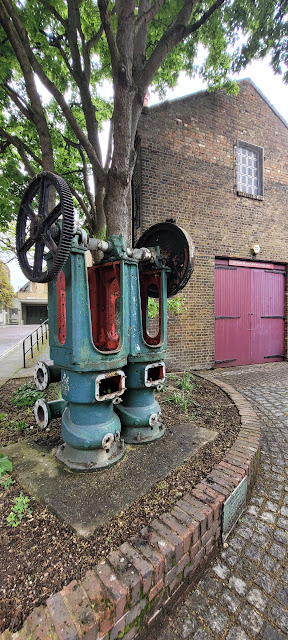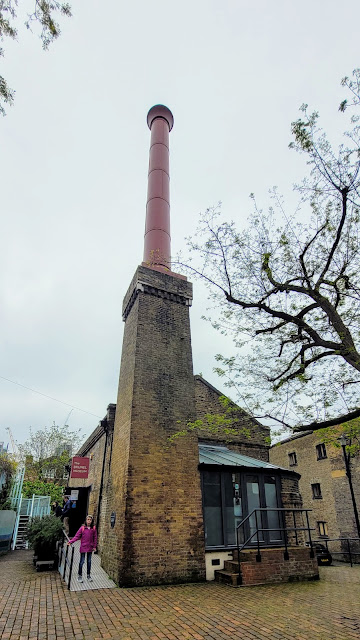 |
| The Mural on the side of the Grand Entrance Hall. |
The Brunel Museum is located within the Brunel Engine House building, Rotherhithe. This small but very informative museum allows you to descend into the Rotherhithe Thames Tunnel Shaft and visit the Engine House, where you will learn exactly what went in to building the world's first tunnel beneath a navigational waterway.
Marc Isambard Brunel designed Engine House as part of the Thames Tunnel project. Steam-powered pumps, used to extract water from the tunnel, were originally housed here, although it was used as a boiler house, between 1825-43.
 |
| A Priming Pump from 1929. |
In 1961 the Brunel Engine House opened and offered visitors the chance to see the interior of the building, as well as the Rennie flat V steam engine.
In 1974 the Engine House and Chimney were Grade II Listed.
Between 1975-79 restoration work to stop structural decay was undertaken and completed.
 |
| The Chimney and Engine House. |
In 2006 the Brunel Engine House changed its name to the Brunel Museum allowing the museum to incorporate other projects by the Brunel's. A new mural was created on the side of the Tunnel Shaft and benches were created in the style of Brunel bridges, in the garden area.
 |
| The Royal Albert Bridge, Saltash, as a bench at the museum. |
Refurbishments, in 2007, included the moving of the Rennie flat V steam engine to the Chatham Historic Dockyard, thus creating a larger exhibition space and improved toilet facilities, within the Engine House.
 |
| Memorabilia for the Thames Tunnel. |
 |
| Looking down into the Thames Tunnel Shaft. |
Marc Isambard Brunel designed and patented an iron shield, within which the miners would stand to excavate the tunnel.
In 1843, following at least six deaths and after nearly taking the life of Marc's son, Isambard, and countless floods, the tunnel was completed and opened as a pedestrian tunnel. The shaft became the Grand Entrance Hall with two spiral staircases, the remains of which can still be seen today.
On its opening it became the world's most popular visitor attraction, with people travelling around the globe to walk through this marvel of engineering. Fairs and banquets, organised by Brunel, were held within the Thames Tunnel to entice even more visitors. It was soon dubbed 'the Eighth Wonder of the World' and welcomed a million visitors in its first three months.
 |
| Smoke-stained walls within the shaft. |
But soon the tunnel took on a more sinister side, with pickpockets and prostitutes using the tunnel for their own means. And so, in 1869, the London Metropolitan Railway bought the tunnel, with the shaft becoming a ventilation shaft for the steam locomotives below.
In 1940 the tunnel shaft was capped with a metal roof, thus preventing the Luftwaffe from seeing the lights from the trains below.
In 2007, following the closure of the East London line for upgrade works, plans were put in place to have a concrete floor installed at the bottom of the shaft. This was completed in 2011.
In 2012 a roof garden is created on top of the tunnel shaft, with a cocktail bar named 'Midnight Apothecary' serving seasonal botanical drinks.
 |
| The new staircase stands apart from the fabric of the building. |
In 2016 a staircase is installed allowing much improved access to the shaft. Before this installation visitors had to crawl through a hatch. The design of the staircase is such that it does not come into contact with the historic fabric of the building.
On the floor of the shaft seats are set out opposite a wall that shows a 4-minute video, on a loop, that tells the story of the Thames Tunnel.
This unique space is also used for concerts, parties, weddings and many other events.
 |
| The entrances to the Thames Tunnel at Wapping station. |
No comments:
Post a Comment